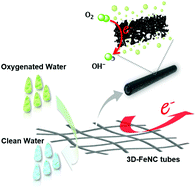Unprecedented capacitive deionization performance of interconnected iron–nitrogen-doped carbon tubes in oxygenated saline water†
Abstract
The exploration of new carbon materials to overcome the rapid performance decay of common carbon materials in oxygenated saline water (i.e., natural saline water) is the biggest challenge for the industrial application of the capacitive deionization (CDI) technology. In this work, we first report the layer-by-layer motif synthesis of 3D interconnected metal–organic framework (MOF) tubes and the derived nitrogen–iron-doped carbon tubes (3D-FeNC tubes) by using continuous polymeric fibers as templates. The elaborately designed 3D-FeNC tubes exhibit multiple advantages, including fast ionic diffusion (originating from the 1D hollow structure of the tubes), efficient electronic pathways and abundant active sites (arising from the 3D interconnected carbon frameworks), which are beneficial for enhancing the oxygen reduction ability. As a consequence, the as-prepared 3D-FeNC tubes exhibit an unprecedented CDI performance in oxygenated saline water with an exceptional salt adsorption capacity of 40.70 mg g−1 and ultrahigh capacity retention of 93.82% even after 200 cycles, highlighting the significance of morphological control and the benefits of hollow structured materials.

- This article is part of the themed collections: Materials Horizons Lunar New Year collection 2021 and 2020 Materials Horizons most popular articles


 Please wait while we load your content...
Please wait while we load your content...